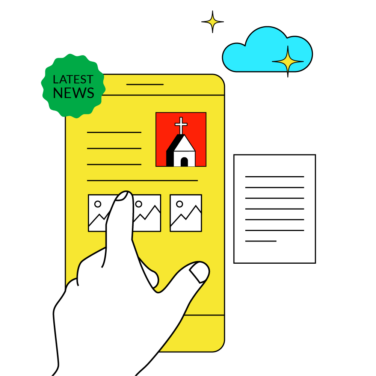I remember some of the hardest days that I have ever had working in ministry were ones that could have been avoided with proper church risk management. And even some of the days where we avoided disaster from happening still haunt me to this day, as the classic “what if” scenarios play out in my mind.
Before I go any further, I would like to warn readers that some of the scenarios that I talk about could be triggering for some, due to the very heavy subject matter.
For instance, I think of times in which a child in our care had to be rushed to the hospital due to an injury that shouldn’t have happened. Other times, I think of the parent not currently in custody of their child who tried to take them (thankfully, unsuccessfully).
We need to be prepared for these moments in the best way possible. This is where a church risk management plan comes into play. There are so many risks that are involved in running churches and other religious organizations, but with a well-written plan in mind, you can at least avoid the worst possible outcome in most scenarios.
I’ll cover:
- What Is A Church Risk Management Plan?
- How To Create A Church Risk Management Plan?
- Church Risk Management Template
What Is A Church Risk Management Plan?
A church risk management plan is your guide and help when it comes to unfortunate circumstances. It is the process you have in place when you are dealing with the possibility of something terrible happening. It is there for two main reasons: to help you avoid and reduce the risk of certain events occurring in the first place.
But we are only human, so the likelihood of something happening eventually is, unfortunately, inevitable. So, the church risk management plan’s second purpose is to help you navigate the solution when bad things do happen. It keeps everyone in your ministry on the same page and is there to prevent a bad situation from worsening.
Risk management is essential to every single church and ministry out there. A church risk management plan is not fun to make nor think about, but you will be glad you did in the end.
How To Create A Church Risk Management Plan
Before you can start implementing your system for noticing and avoiding bad situations, you must first create a physical church risk management plan. This will be your go-to document in emergencies, and you must share it with every staff member, volunteer, pastor, leader, and anyone else who might assist in your organization.
In order to make one of these plans, there are four main steps that I would like for you to consider. These are crucial parts of mitigating risks. I will break down each one of the steps fully, and provide some insights and lessons learned from my time in ministry.
1. Identify Risks in Your Church Environment
Before we can go any further, we need to know the risks that exist in our environment. There are a lot of risks and issues that can pop up in every church out there. But there are some that are unique to certain types of ministries and locations. In order to avoid unfortunate situations, you need to know what you are looking for.
Here is a list of the main risks that I have seen in my time in dealing with church safety. This is not an exhaustive list and there may be situations that were not relevant to me that are to you. Also, I would like to reiterate that this list and this article in general may be triggering for some people, so please remember that before continuing.
- Accidents
- Accusations
- Assault
- Drugs
- Fights
- Fires
- Flooding
- Harassment
- Inebriated Attendees
- Injuries
- Kidnapping
- Lawsuits
- Medical Emergencies
- Natural Disasters
- Power Outages
- Self-Harm
- Shooting
- Stealing Church Funds
- Theft
- Vandalism
This is absolutely not a full list of everything that you might deal with when it comes to church safety. These are just some of the main problems that I have seen and even dealt with. Identifying risks is all about knowing what could possibly happen, and then planning ahead with that in mind.
For example: I was the assistant director in the children’s ministry at a medium-sized church. Drugs and fights were particularly problematic (yes, even for children). We had a bus system that brought in thousands of children from across Los Angeles County to our church every Thursday night and Sunday morning.
Some of these children did not know anything beyond fighting to get their point across or messing around with drugs. As such, these were prominent issues that we had to deal with in our congregation, both with kids and adults alike. Since this was an obvious risk that we constantly had to consider, there were many plans and scenarios that we put in place.
Because of this, we had systems in place so that when someone was doing heroin in the bathroom, we knew what to do next. Or when two kids started punching the living lights out of one another, we had the solution for how to deal with both of them and notify their parents.
Once you know the main risks that are highly possible within your church (and ones that are not as common), you can prepare for that.
2. Assess Risks and Their Impacts
It isn’t enough to just identify a risk, though, as we need to assess the level of risk as well. Some potential risks are more likely than others and some issues are going to have a more negative impact than others. In general, these are the four categories that you should divide your previously identified risks into:
- Low likelihood and low impact: These situations will rarely happen and when they do, it is easily taken care of.
- Low likelihood and high impact: These risks rarely happen, but will devastate your congregation and your leadership if they do occur.
- High likelihood and low impact: These are common scenarios that can regularly happen but are easily handled when they do.
- High likelihood and high impact: The worst of the four categories. These are high risk scenarios that can often happen and will affect everyone around when they do.
What this means is that some risks are very unlikely, while others are extremely likely. For instance, (and this is generalizing), the chances of a child being injured in your children’s ministry is pretty much guaranteed. Kids are going to play, run around, and have fun, and someone will eventually get hurt.
They will run into each other, punch each other, and so on. That is a very high likelihood scenario in just about every church out there. On the other hand, a low likelihood situation might be flooding, depending on your location, and which you can prepare for ahead of time.
However, there is a second part to this, which is the impact that a situation can have. Low impact situations are ones that have minimal consequences after the scenario and, therefore, can be dealt with swiftly and securely. Thinking back to kids, minor injuries like bruises and bumps are low impact.
They also have a high chance of happening, but they are minor enough that you should be able to handle them with ease. On the other hand, high impact scenarios are the worst of the worst. These are the dire situations that you wish to avoid at all costs. This is something like a fire or kidnapping, which can devastate the entire church, community, and everyone in it.
To know the difference between low and high likelihood level of risk, you simply need to look at your church environment. If your community doesn’t have a high drug rate, then perhaps drug dealing at your church may not be too much of a concern.
On the other hand, if your area has a lot of rain and storms, things like tornadoes, power outages, and flooding might be seriously high likelihood issues that require insurance and other assurances.
3. Mitigate Risks to Avoid Disaster
You have your risks figured out and you’ve categorized them, now it is time to take action. With the four categories of risks in mind, the next step is to take those risks and do whatever you possibly can to prevent them. Each situation will require different processes for the mitigation of risk, but there are some general rules of thumb.
Let’s break down each of the four categories. I think that the low likelihood, low impact scenario is the least concerning of the bunch. This is one of the areas of risk where you can come up with some solutions to these problems, put them in place, or create a document for when they happen.
For example, let’s say that a low risk, low impact scenario is vandalism of your church property. Graffiti and the like might not be too common and it wouldn’t be too serious if someone did it. In this case, all you might do is put some cameras in the alleys and outside parts of your church property to catch anyone who does it. You could also have a cleaning crew in place in case it did happen.
On the other hand, a low risk and high impact scenario involves a lot more. These need highly detailed back-up plans and systems in place to keep them at a low risk. For example, fire is, hopefully, not too common, but what are you doing to keep it that way?
You need to ensure that the proper fire safety codes are followed, as well as go above and beyond. You might make it a rule that only properly trained staff members can cook. Strictly enforce no smoking on the premises. And create exit plans that everyone knows about and practice them every so often.
High likelihood and low impact scenarios may not sound that bad, but don’t take them lightly. Due to the high risk of these situations happening, they need proper attention and prevention to ensure that their impacts remain low. I recommend constant reminders, training, and detailed plans to mitigate the consequences of these scenarios.
For instance, as before, I would consider a high likelihood, low impact scenario to be a minor injury resulting from a kid hitting another child. Just because it might be a little bruise that doesn’t require medical attention doesn’t mean you don’t take it seriously. If a child is known to be violent, take proper measures to avoid them hurting someone.
For example, I have had to ban or suspend (usually temporarily) kids 12 and younger from riding the bus before and it was one of the hardest decisions of my life, but it was necessary to protect the others. Sometimes these high risk, low impact situations have simple enough solutions, but don’t let them go ignored because they don’t seemingly matter that much.
If you ignore them too much, they can and will turn into high impact scenarios.
Speaking of high impact, there are the high risk and high result situations that are the most devastating and alarming. These require the utmost care, attention, and planning possible. Pour all of your safety resources and risk management resources into preventing these situations from happening, but know that they can and possibly will happen.
As such, you need an equal balance of prevention and solution. There is a strong chance that it will happen at some point. You need equally solid back-up plans for how to deal with these situations when they happen. These are not easy or fun to deal with and are absolutely the most challenging parts of risk management.
An example of this was an inebriated churchgoer, in my experience. As mentioned, we brought in adults to the church, and many times they would be drunk or high. This was high impact since they could possibly attack someone, disrupt the entire service, or even try to run onto the stage.
These are the hardest scenarios but there are possible prevention methods if you have the proper action plans in place. In our case, we had guards around the facility, watching everyone, and guarding the stage at all times.
It was not fun and it didn’t look good for a church, but it was necessary. And we had great connections with the local authorities for effectively and immediately dealing with someone as soon as they showed signs of disruption. On a related note, I always suggest background checks for all volunteers and employees.
A church security checklist can help you with mitigating risks.
4. Document And Monitor Risks
You’ve conducted a risk assessment, categorized potential risks, and are putting risk control measures in place for each of them. Now it is time for the nitty-gritty of the church risk management plan. This isn’t a fun step, either, but is equally as necessary. It is time to start documenting and keeping track of the risks that are in your church.
This means creating documents and formal risk management policies to note the issues in your church and what you have done recently to prevent them. This is where you check off the last time you did a fire drill or checked the locks on all of your windows and doors. This step is also where you create your church security plans for how to prevent situations and what to do when they happen.
It is also here that you begin to monitor the risks in your local church. Keep track of the likelihood and impact of the risk and what you are doing to help with that. And if a situation has already happened, keep track of how it happened, why it happened, and what you will do to learn from that.
For example, monitoring risks might include keeping track of everyone who knows the password to your computers to prevent theft. You might also be changing the password every couple of months as part of your prevention strategy. This way, you’re reducing the likelihood of theft, and you’ll have a list of everyone who knows the password so you’ll be in the know in the event of a possible theft.
Church Risk Management Plan Template
With all of this in mind, it can be overwhelming coming up with a church risk management plan or checklists for your church. But it is absolutely, 100% necessary. All of the volunteers, church leaders, and so on that are involved in working in your ministry should be aware of risks and mitigation plans in the form of checklists, documents, etc.
To help with this, here is a very basic and simple church risk management template that you can use as a foundation for your church.
Risk Management Starts With Our Leaders
Running a church or ministry is not easy, and dealing with church risk management is never fun. However, it is one of the most foundational and necessary components of running an effective, safe, and Godly ministry.
We cannot share the love of God without first caring for all our fellow humans and ensuring that they are safe and protected in all possible ways. Sure, mistakes are going to happen but that is why we have to adequately plan above and beyond for those unfortunate scenarios.
That is why church risk management is not fun, but making a plan is absolutely required. With that said, I get that this was not the most exciting topic to talk about. A security team is important to risk and crisis management. Read more about church security teams and church security manuals here.
That is why I recommend checking out our article on how to mentor and build devoted youth leaders next. This is far more fun and lighthearted compared to the heaviness here. Plus, training our church staff in a sufficient way will set them up for assisting in risk management procedures and dealing with any potential church crises that may arise.


